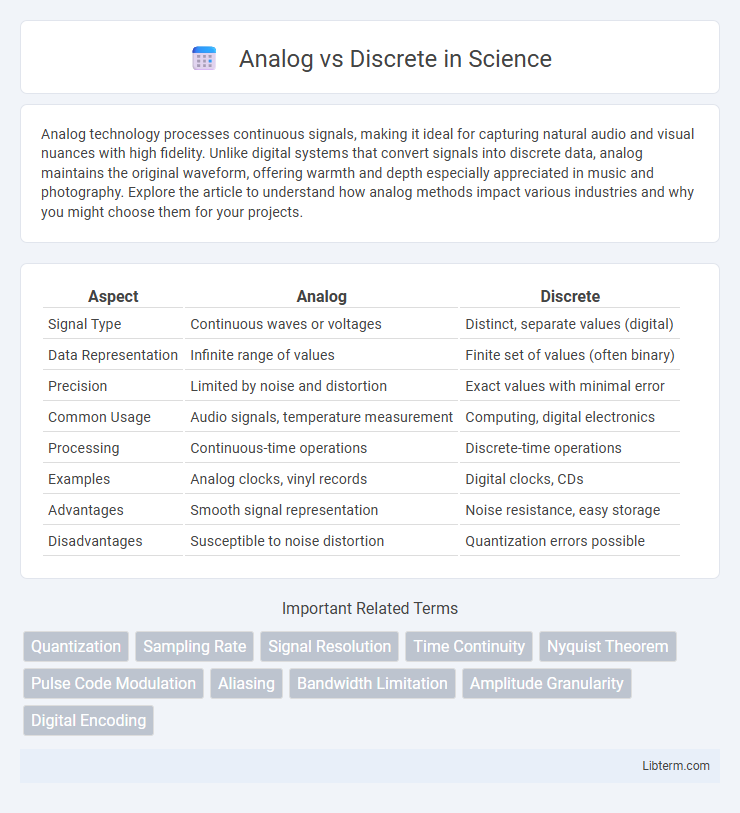Analog technology processes continuous signals, making it ideal for capturing natural audio and visual nuances with high fidelity. Unlike digital systems that convert signals into discrete data, analog maintains the original waveform, offering warmth and depth especially appreciated in music and photography. Explore the article to understand how analog methods impact various industries and why you might choose them for your projects.
Table of Comparison
| Aspect | Analog | Discrete |
|---|---|---|
| Signal Type | Continuous waves or voltages | Distinct, separate values (digital) |
| Data Representation | Infinite range of values | Finite set of values (often binary) |
| Precision | Limited by noise and distortion | Exact values with minimal error |
| Common Usage | Audio signals, temperature measurement | Computing, digital electronics |
| Processing | Continuous-time operations | Discrete-time operations |
| Examples | Analog clocks, vinyl records | Digital clocks, CDs |
| Advantages | Smooth signal representation | Noise resistance, easy storage |
| Disadvantages | Susceptible to noise distortion | Quantization errors possible |
Introduction to Analog and Discrete Systems
Analog systems process continuous signals representing physical quantities, offering smooth and natural data variations often used in audio, temperature sensing, and voltage measurement. Discrete systems handle digital signals characterized by distinct, separate values, ideal for computation, digital communication, and data storage applications. Understanding the fundamental differences in signal representation and processing methods is crucial for selecting the appropriate system in engineering and technology fields.
Defining Analog Signals
Analog signals represent continuous variations of physical quantities, characterized by infinite possible values within a given range, such as voltage or sound waves. These signals encode information through amplitude, frequency, or phase changes that directly correspond to real-world phenomena. Unlike discrete signals, analog signals provide smooth, uninterrupted data suitable for capturing natural and complex variations.
Understanding Discrete Signals
Discrete signals represent information at distinct, separate points in time, characterized by specific amplitude values rather than a continuous range. They are fundamental in digital communications, computer processing, and signal sampling, enabling precise manipulation and analysis through algorithms. Understanding discrete signals involves recognizing their representation as sequences of numbers, which facilitates digital storage, transmission, and error correction.
Key Differences Between Analog and Discrete
Analog signals vary continuously over time, representing data with infinite possible values, while discrete signals consist of distinct, separate values usually represented in binary form. Analog systems are susceptible to noise and distortion, affecting signal quality, whereas discrete systems offer greater noise immunity and easier data processing. The fundamental difference lies in analog's continuous variability versus discrete's stepwise, finite states, impacting applications like audio processing and digital communication.
Common Applications of Analog Systems
Analog systems are widely used in audio and video equipment, where continuous signal variations ensure high fidelity and natural sound reproduction. In instrumentation and control systems, analog signals enable precise measurement and real-time monitoring of parameters such as temperature, pressure, and voltage. Communication technologies like AM and FM radio employ analog transmission for robust signal processing in environments with varying noise levels.
Common Applications of Discrete Systems
Discrete systems are widely used in digital electronics, control systems, and computer programming where signals are binary or quantized, enabling precise data processing and logic operations. Applications include microprocessors, digital communication networks, and embedded systems in automotive controls and consumer electronics. These systems excel in environments requiring error detection, data storage, and digital signal processing.
Advantages of Analog Systems
Analog systems offer continuous signal representation, enabling precise and smooth variations in data such as sound and temperature. Their simplicity in design often results in lower cost and easier real-time processing compared to discrete systems. These systems excel in real-world applications where accurate capture of natural phenomena is critical, such as audio amplification and sensor signal processing.
Advantages of Discrete Systems
Discrete systems offer precise control and enhanced reliability by processing distinct signals, reducing noise interference common in analog systems. Their digital nature enables easier integration with computer algorithms and software, facilitating advanced data analysis and automation. These systems also provide improved reproducibility and scalability, essential for modern technological applications.
Challenges in Analog and Discrete Processing
Analog processing faces challenges such as noise susceptibility, signal distortion, and limited precision due to continuous signal variations. Discrete processing encounters issues with quantization errors, finite resolution, and increased computational complexity when handling large data sets. Both methods require careful design to balance accuracy, speed, and resource consumption in applications like audio signal processing and digital communications.
Choosing Between Analog and Discrete Approaches
Choosing between analog and discrete approaches depends on factors such as signal type, precision requirements, and system complexity. Analog systems excel in continuous signal processing and smooth data representation, while discrete systems offer enhanced noise immunity, ease of digital processing, and scalability in complex applications. Evaluating application-specific needs like resolution, bandwidth, and integration capabilities guides the selection of the optimal approach for efficient and accurate performance.
Analog Infographic

 libterm.com
libterm.com